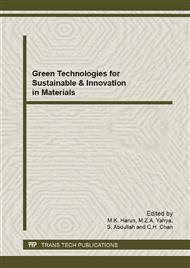p.33
p.44
p.49
p.56
p.65
p.71
p.79
p.86
p.92
Qualitative Analysis of the Effect of Polymer Solution and Suspension Properties on the Electrospinning of Nanocomposite Fibers
Abstract:
Nanocomposite fibers produced via electrospinning have very large surface area by virtue of their nanometer diameter sizes thereby making them very attractive for various applications such as for adsorption of contaminants from wastewater. In this study, a highly adsorbing nanoparticle, iron-modified montmorillonite was used as filler in the nanocomposite. The effects of polymer solution and suspension properties such as polymer concentration, clay loading, and filler type on the electrospinning of the nanocomposite were investigated using a 2k factorial design of experiment. The types of montmorillonite used were zero valent iron-MMT (ZVIMMT) and iron (III)-MMT (FeMMT). It was found from the SEM images that finer fibers were generated from suspensions with lower polymer concentration in the solution specifically at 5 wt% and from suspensions with ZVIMMT particles as filler. However, a common defect in nanofibers called beads was also observed in the fibers produced from 5 wt% polymer concentration. TEM micrographs confirmed that the ZVIMMT fibers have smaller diameter than the FeMMT fibers. In addition, it was recognized that the layered structure of the clay is still intact after the electrospinning process. The XRD pattern of the fibers revealed that the clay particles were intercalated with the polymer molecules based on the calculated d-spacing. Furthermore, elemental analysis on the bead and string regions of the electrospun fibers confirmed the presence of polymer and montmorillonite particles in both regions.
Info:
Periodical:
Pages:
65-70
Citation:
Online since:
April 2013
Keywords:
Price:
Сopyright:
© 2013 Trans Tech Publications Ltd. All Rights Reserved
Share:
Citation:


